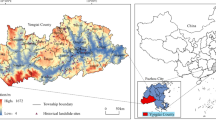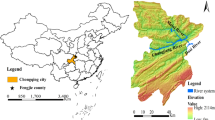Abstract
The “4.20” Lushan earthquake in Sichuan province, China has induced a large amount of geological hazards and produced abundant loose materials which are prone to post-earthquake rainfall-triggered landslides. A detailed landslide inventory was acquired through post-earthquake emergent field investigation and high resolution remote sensing interpretation. The rainfall analysis was conducted using historical rainfall records during the period from 1951 to 2010. Results indicate that the average annual rainfall distribution is heterogeneous and the largest average annual rainfall occurs in Yucheng district. The Stability Index MAPping (SINMAP) model was adopted to assess and analyze the post-earthquake slope stability under different rainfall scenarios (light rainfall, moderate rainfall, heavy rainfall, and rainstorm). The model parameters were calibrated to reflect the significant influence of strong earthquakes on geological settings. The slope stability maps triggered by different rainfall scenarios were produced at a regional scale. The effect of different rainfall conditions on the slope stability is discussed. The expanding trend of the unstable area was quantitatively assessed with the different critical rainfall intensity. They provide a new insight into the spatial distribution and characteristics of post-earthquake rainfall-triggered landslides in the Lushan seismic area. An increase of rainfall intensity results in a significant increase of unstable area. The heterogeneous distribution of slope instability is strongly correlated with the distribution of earthquake intensity in spite of different rainfall conditions. The results suggest that the both seismic intensity and rainfall are two crucial factors for post-earthquake slope stability. This study provides important references for landslide prevention and mitigation in the Lushan area after earthquake.
Similar content being viewed by others
References
Aleotti P, Chowdhury R (1999) Landslide hazard assessment: summary review and new perspectives. Bulletin of Engineering Geology and the Environment 58: 21–44. DOI: 10.1007/s100640050066
Baum RL, Godt JW, Savage WZ (2010) Estimating the timing and location of shallow rainfall-induced landslides using a model for transient, unsaturated infiltration. Journal of Geophysical Research 115: F03013. DOI: 10.1029/2009JF001321
Chang SB, Zhang SM (2006) Engineering Geology Manual (fourth edition). Beijing: China Architecture and Building Press. (In Chinese)
Chen XQ, Cui P, You Y, et al. (2013) Secondary mountain disasters induced by the 4·20 Lushan earthquake and disaster mitigation. Earth Science Frontiers 20: 29–34. (In Chinese)
China Earthquake Administration.http://www.cea.gov.cn/publish/dizhenj/468/553/100342/index.html, 2013-4-23. (In Chinese)
Cui P, Wei FQ, He SM, et al. (2008) Mountain Disasters Induced by the Earthquake of May 12 in Wenchuan and the Disasters Mitigation. Journal of Mountain Science 26: 280–282. (In Chinese)
Deb SK, El-Kadi AI (2009) Susceptibility assessment of shallow landslides on Oahu, Hawaii, under extreme-rainfall events. Geomorphology 108: 219–233. DOI: 10.1016/j.geomorph.2009.01.009
Dietrich WE, Reiss R, Hsu ML, et al. (1995) A process-based model for colluvial soil depth and shallow landsliding using digital elevation data. Hydrological Processes 9: 383–400. DOI: 10.1002/hyp.3360090311
Guzzetti F, Carrara A, Cardinali M, et al. (1999) Landslide hazard evaluation: a review of current techniques and their application in a multi-scale study, Central Italy. Geomorphology 31: 181–216. DOI: 10.1016/S0169-555X(99) 00078-1
He SM, Li DX, Wu Y, et al. (2011) Study on the Rainfall and Aftershock Threshold for Debris Flow of Post-earthquake. Journal of Mountain Science 8: 750–756. DOI: 10.1007/11629-011-2046-2
Lan HX, Zhou CH, Wang LJ, et al. (2004) Landslide hazard spatial analysis and prediction using GIS in the Xiaojiang watershed, Yunnan, China. Engineering Geology 76: 109–128. DOI: 10.1016/j.enggeo.2004.06.009
Lan HX, Wu FQ, Zhou CH, et al. (2003) Spatial hazard analysis and prediction on rainfall-induced landslide using GIS. Chinese Science Bulletin 48: 703–708. DOI: 10.1007/BF03325659
Liang QG, Han WF, Li XF (2009) Discussion on seismic failure of rock mass in meizoseismal areas. Rock and Soil Mechanics 30(supplement): 37–40. (In Chinese)
Lin CW, Shieh CL, Yuan BD, et al. (2004) Impact of Chi-Chi earthquake on the occurrence of landslides and debris flows: example from the Chenyulan River watershed, Nantou, Taiwan. Engineering Geology 71: 49–61. DOI: 10.1016/S0013-7952(03)00125-X
Lin CW, Liu SH, Lee SY, et al. (2006) Impacts of the Chi-Chi earthquake on subsequent rainfall-induced landslides in central Taiwan. Engineering Geology 86: 87–101. DOI: 10.1016/j.enggeo.2006.02.010
Meisina C, Scarabelli S (2007) A comparative analysis of terrain stability models for predicting shallow landslides in colluvial soils. Geomorphology 87: 207–223. DOI:10.1016/j.geomorph.2006.03.039
Miles SB, Keefer DK (2009) Toward a comprehensive areal model of earthquake-induced landslides. Natural Hazards Review 10: 19–28. DOI: 10.1061/(ASCE)1527-6988(2009)10:1(19)
Montgomery DR, Dietrich WE (1994) A physically based model for the topographic control on shallow landsliding. Water Resources Research 30: 1153–1171. DOI: 10.1029/93WR02979
Muntohar AS, Liao HJ (2010) Rainfall infiltration: infinite slope model for landslides triggering by rainstorm. Natural Hazards 54: 967–984. DOI: 10.1007/s11069-010-9518-5
Pack RT, Tarboton DG, Goodwin CN (1998) The SINMAP approach to terrain stability mapping. In: Moore D, Hungr O, Proceedings of eighth international congress international association for engineering geology and the environment. Vancouver, Canada. pp 1157–1165.
Pack RT, Tarboton DG, Goodwin CN (2005) A stability index approach to terrain stability hazard mapping. SINMAP user’s manual.
Schulz WH, McKenna JP, Kibler JD (2009) Relations between hydrology and velocity of a continuously moving landslide — evidence of pore-pressure feedback regulating landslide motion. Landslides 6: 181–190. DOI: 10.1007/s10346-009-0157-4
Shieh CL, Chen YS, Tsai YJ, et al. (2009) Variability in rainfall threshold for debris flow after the Chi-Chi earthquake in central Taiwan, China. International Journal of Sediment Research 24: 177–188. DOI: 10.1016/S1001-6279(09)60025-1
Simoni A, Berti M, Generali M (2004) Preliminary result from pore pressure monitoring on an unstable clay slope. Engineering Geology 73: 117–128. DOI: 10.1016/j.enggeo.2003.12.004
Tang C, Zhu J, Li WL, et al. (2009) Rainfall-triggered debris flows following the Wenchuan earthquake. Bulletin of Engineering Geology and the Environment 68: 187–194. DOI: 10.1007/s10064-009-0201-6
Terhorst B, Kreja R (2009) Slope stability modelling with SINMAP in a settlement area of the Swabian Alb. Landslides 6: 309–319. DOI: 10.1007/s10346-009-0167-2
Vidrih R, Ribičič M, Suhadolc P (2001) Seismogeological effects on rocks during the 12 April 1998 upper Soča Territory earthquake (NW Slovenia). Tectonophysics 330: 153–175. DOI: 10.1016/S0040-1951(00)00219-5
Wu Y, He SM, Luo Y, et al. (2011) Failure Mechanisms of Post-Earthquake Bedrock Landslides in Response to Rainfall Infiltration. Journal of Mountain Science 8: 96–102. DOI: 10.1007/s11629-011-2074-y
Xu XW, Chen GH, Yu GH, et al. (2013) Seismogenic structure of the Lushan earthquake and its relationship with The Wenchuan earthquake. Earth Science Frontiers 20: 11–20. (In Chinese)
Zhang Y, Cheng YL, Li CS, et al. (2011) Comparatives study on geological disasters before and after Wenchuan earthquake. Journal of Engineering Geology 19(supplement): 179–185. (In Chinese)
Zhang YS, Dong SW, Hou CT, et al. (2013) Geohazards induced by the Lushan Ms7.0 earthquake in Sichuan Province, Southwest China: typical examples, types and distributional characteristics. Acta Geologica Sinica (English Edition) 87: 646–657. DOI: 10.1111/1755-6724.12076
Zhang YS, Cheng YL, Yin YP, et al. (2014) High-position debris flow: a long-term active geohazard after the Wenchuan earthquake. Engineering Geology 180: 45–54. DOI: 10.1016/j.enggeo.2014.05.014
Author information
Authors and Affiliations
Corresponding author
Additional information
0000-0002-4372-3431
0000-0002-7146-932X
0000-0002-5574-6083
0000-0001-6398-3161
0000-0003-1659-028X
0000-0001-8562-5445
0000-0003-0787-9866
Rights and permissions
About this article
Cite this article
Yang, Zh., Lan, Hx., Liu, Hj. et al. Post-earthquake rainfall-triggered slope stability analysis in the Lushan area. J. Mt. Sci. 12, 232–242 (2015). https://doi.org/10.1007/s11629-013-2839-6
Received:
Accepted:
Published:
Issue Date:
DOI: https://doi.org/10.1007/s11629-013-2839-6




